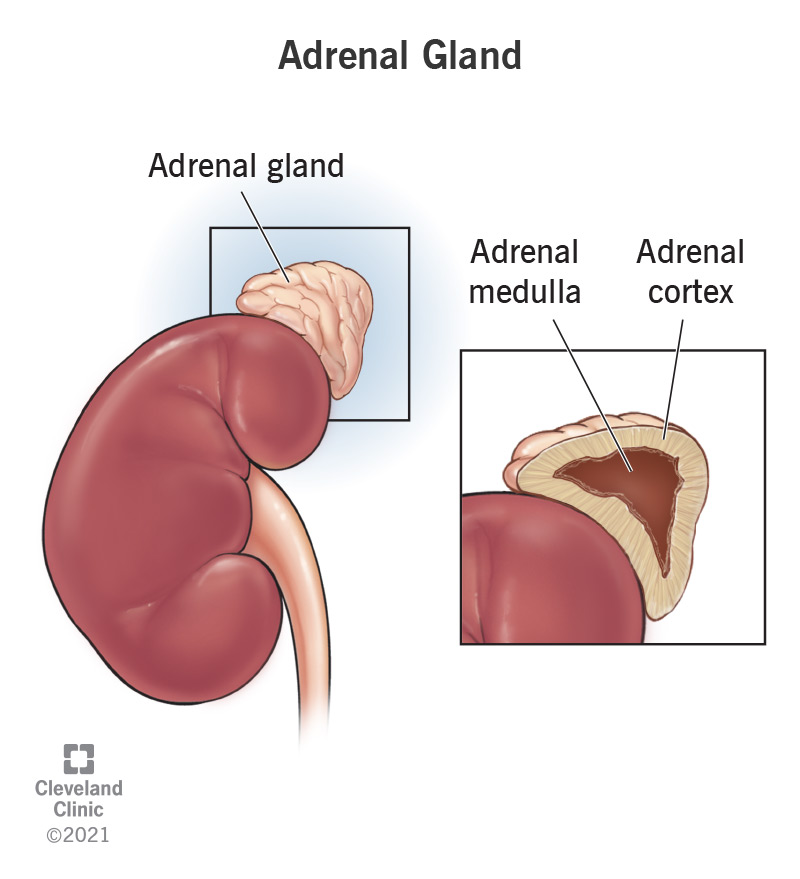Your adrenal glands are endocrine glands located on top of your kidneys. They produce many important hormones, including cortisol, aldosterone and adrenaline. The adrenal hormones help regulate several bodily functions including metabolism, blood pressure and your body's response to stress.

Your adrenal glands, also known as suprarenal glands, are small, triangle-shaped glands that are located on top of each of your two kidneys. They’re a part of your endocrine system and produce certain hormones that help regulate several important bodily functions, including:
Your adrenal glands are composed of two parts: the cortex (outer region) and the medulla (inner part). Each part is responsible for producing different hormones.
Cleveland Clinic is a non-profit academic medical center. Advertising on our site helps support our mission. We do not endorse non-Cleveland Clinic products or services. Policy
Your endocrine system is a network of several glands that create and secrete (release) hormones.
A gland is an organ that makes one or more substances, such as hormones, digestive juices, sweat or tears. Endocrine glands release hormones directly into your bloodstream.
Hormones are chemicals that coordinate different functions in your body by carrying messages through your blood to your organs, skin, muscles and other tissues. These signals tell your body what to do and when to do it.
The following organs and glands make up your endocrine system:
Your adrenal glands are responsible for producing and releasing the following essential hormones:
These hormones can be categorized into two broad groups:
Many other parts of your body interact with your adrenal glands, including:
Your adrenal glands are controlled in part by your hypothalamus and pituitary gland. The hypothalamus, a small area of your brain involved in hormonal regulation, produces corticotropin-releasing hormone (CRH) and antidiuretic hormone (ADH, or vasopressin). ADH and CRH trigger your pituitary gland to release corticotropin (adrenocorticotropic hormone or ACTH), which stimulates your adrenal glands to produce corticosteroids, such as cortisol and aldosterone.
Your kidneys play a part in causing your adrenal glands to produce more or less aldosterone, and your sympathetic nervous system regulates the release of adrenaline and noradrenaline from your adrenal glands.
Your adrenal glands produce hormones that you can't live without, including sex hormones and cortisol. Although it’s rare, you can have both of your adrenal glands surgically removed (adrenalectomy) to treat certain adrenal conditions. People who have this surgery need to take certain medications for life to replace the adrenal gland hormones.
You have two adrenal glands that are located on top of each of your kidneys. Your kidneys are located underneath your ribcage on each side of your spine.
Both of your adrenal glands consist of two main parts:
Adrenal glands are normally about a half-inch high and three inches long. They’re shaped like rounded triangles.
There are several different adrenal gland disorders. They happen when your adrenal glands make too much or not enough of one or more hormones. Some adrenal conditions are temporary, whereas others are chronic (lifelong).
Causes of adrenal gland disorders include:
Adrenal gland conditions include:
The symptoms of adrenal gland issues vary depending on which hormones are affected. Many of the symptoms of adrenal disorders are similar to those of other illnesses.
Signs and symptoms that are relevant to the bodily processes your adrenal gland hormones affect include:
If you’re experiencing symptoms of possible adrenal gland issues, your healthcare provider can order certain blood and urine tests that measure the level of different adrenal hormones.
If the results reveal abnormal levels, your provider may order imaging tests such as CT (computed tomography) scans or MRIs (magnetic resonance imaging).
Your regular healthcare provider may refer you to an endocrinologist, a specialist in hormones and diseases of the endocrine system.
If you have concerning symptoms such as high or low blood pressure and unexplained weight loss or weight gain, reach out to your healthcare provider. While many conditions could cause these symptoms, it could be an issue with your adrenal glands.
A note from Cleveland Clinic
Your adrenal glands produce many important hormones that are necessary for everyday bodily functions. If you have any adrenal disorder-related symptoms or want to know if you have any risk factors for developing an adrenal condition, don’t be afraid to talk to your healthcare provider. They’re there to help you.
Last reviewed by a Cleveland Clinic medical professional on 05/13/2022.
Learn more about our editorial process.
Cleveland Clinic is a non-profit academic medical center. Advertising on our site helps support our mission. We do not endorse non-Cleveland Clinic products or services. Policy